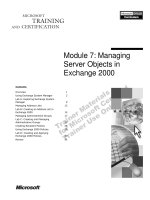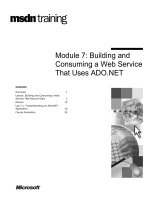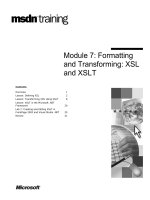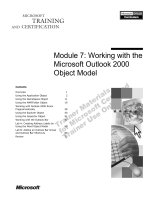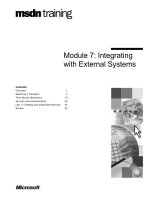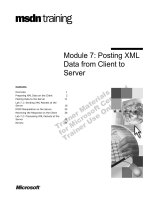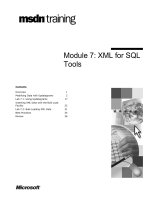Tài liệu Module 7: Essentials of Object-Oriented Programming pdf
Bạn đang xem bản rút gọn của tài liệu. Xem và tải ngay bản đầy đủ của tài liệu tại đây (1.03 MB, 68 trang )
Contents
Overview 1
Classes and Objects 2
Using Encapsulation 10
C# and Object Orientation 21
Lab 7.1: Creating and Using Classes 39
Defining Object-Oriented Systems 52
Review 61
Module 7: Essentials of
Object-Oriented
Programming
Information in this document, including URL and other Internet Web site references, is subject to
change without notice. Unless otherwise noted, the example companies, organizations, products,
domain names, e-mail addresses, logos, people, places, and events depicted herein are fictitious,
and no association with any real company, organization, product, domain name, e-mail address,
logo, person, places or events is intended or should be inferred. Complying with all applicable
copyright laws is the responsibility of the user. Without limiting the rights under copyright, no
part of this document may be reproduced, stored in or introduced into a retrieval system, or
transmitted in any form or by any means (electronic, mechanical, photocopying, recording, or
otherwise), or for any purpose, without the express written permission of Microsoft Corporation.
Microsoft may have patents, patent applications, trademarks, copyrights, or other intellectual
property rights covering subject matter in this document. Except as expressly provided in any
written license agreement from Microsoft, the furnishing of this document does not give you any
license to these patents, trademarks, copyrights, or other intellectual property.
2001−2002 Microsoft Corporation. All rights reserved.
Microsoft, MS-DOS, Windows, Windows NT, ActiveX, BizTalk, IntelliSense, JScript, MSDN,
PowerPoint, SQL Server, Visual Basic, Visual C++, Visual C#, Visual J#, Visual Studio, and
Win32 are either registered trademarks or trademarks of Microsoft Corporation in the U.S.A.
and/or other countries.
The names of actual companies and products mentioned herein may be the trademarks of their
respective owners.
Module 7: Essentials of Object-Oriented Programming iii
Instructor Notes
This module provides students with the basic theory, concepts, and terminology
of object-oriented programming. It also provides a minimal amount of C#
syntax, specifically for implementing encapsulation.
After completing this module, students will be able to:
Define the terms object and class in the context of object-oriented
programming.
Define the three core aspects of an object: identity, state, and behavior.
Describe abstraction and how it helps you to create reusable classes that are
easy to maintain.
Use encapsulation to combine methods and data in a single class and
enforce abstraction.
Explain the concepts of inheritance and polymorphism.
Create and use classes in C#.
Materials and Preparation
This section provides the materials and preparation tasks that you need to teach
this module.
Required Materials
To teach this module, you need the following materials:
Microsoft
®
PowerPoint
®
file 2124C_07.ppt
Module 7, “Essentials of Object-Oriented Programming”
Lab 7, Creating and Using Classes
Preparation Tasks
To prepare for this module, you should:
Read all of the materials for this module.
Complete the lab.
Presentation:
60 Minutes
Lab:
45 Minutes
iv Module 7: Essentials of Object-Oriented Programming
Module Strategy
Use the following strategy to present this module:
Classes and Objects
In teaching this course, sometimes you will use a particular word to mean a
class (all examples), and sometimes you will use the same word to mean an
object (a specific example). Make sure that students understand the
difference. Correct them if they misuse the terminology.
Object identity can be difficult to teach. A useful analogy involves a
scenario of a being in a restaurant and not being able to read the menu.
(Perhaps it is in French.) However, you see another diner at a nearby table
eating a dish that looks and smells great. You decide that you want the same
dish. You capture the attention of a passing waiter and say, “I’ll have what
they’re having.” There are two outcomes. In the “with-identity” outcome,
the waiter goes to the other table, takes the diner’s plate away, and gives it
to you! In the “without-identity” outcome, the waiter goes to the kitchen and
tells the chef the name of the dish, and the chef then cooks another copy of
that dish by using another set of the same ingredients. The concept of
identity can be summed up in a question: Do you need the actual object, or
is a copy good enough?
Using Encapsulation
This section provides the motivation for combining data and methods. It
provides the answer to the question, “Why encapsulate?” This section also
provides a small amount of C# syntax for creating encapsulated classes.
A top-level class cannot be declared private. It is best not to spend too much
time on top-level visibility: this topic is covered in a later module.
Nested classes are not covered in the lab exercises.
C# and Object Orientation
This section explains the terminology and concepts of object-oriented
programming.
Defining Object-Oriented Systems
The word system in this section is used to emphasize the higher-level
structure that inheritance provides. Class hierarchy design is essentially
framework design and requires thought and experience. Do not spend too
much time on detailed explanations. Remember that the primary aim of this
module is to teach the theory. In keeping with this aim, the slides use
Unified Modeling Language (UML) notation.
Be sure to read the notes in the Inheritance topic and explain why the man,
woman, and child relationship is not a good example of object-oriented
inheritance. Inheritance is misunderstood and misused in object-oriented
programming, so it is a good idea to dispel a few misunderstandings right
away.
Do not spend too much time on single and multiple inheritance at this time.
Remember, you have not yet covered interfaces.
Module 7: Essentials of Object-Oriented Programming v
Polymorphism is a long word with a simple meaning. It is something that all
human beings instinctively do. It is a natural part of classification. You
might want to use a simple example. Ask a student what time it is. Ask
another student the same question, and then ask another student. You will
get a variety of different implementations and responses. Some students will
look at their watches. Some will look at a clock. Some will be clever and
just repeat the previous answer (caching!).
The section does not over-emphasize that derived classes can add their own
methods. Most textbooks over-emphasize this. The major benefit of class
hierarchies is polymorphism.
In the Early and Late Binding topic, do not spend too much time explaining
how late binding works.
Module 7: Essentials of Object-Oriented Programming 1
Overview
Classes and Objects
Using Encapsulation
C# and Object Orientation
Defining Object-Oriented Systems
*****************************
ILLEGAL FOR NON
-
TRAINER USE
******************************
C# is an object-oriented programming language. In this lesson, you will learn
the terminology and concepts required to create and use classes in C#.
After completing this module, you will be able to:
Define the terms object and class in the context of object-oriented
programming.
Define the three core aspects of an object: identity, state, and behavior.
Describe abstraction and how it helps you to create reusable classes that are
easy to maintain.
Use encapsulation to combine methods and data in a single class and
enforce abstraction.
Explain the concepts of inheritance and polymorphism.
Create and use classes in C#.
Topic Objective
To provide an overview of
the module topics and
objectives.
Lead-in
In this module, you will learn
more details about classes
and objects.
2 Module 7: Essentials of Object-Oriented Programming
Classes and Objects
What Is a Class?
What Is an Object?
Comparing Classes to Structs
Abstraction
*****************************
ILLEGAL FOR NON
-
TRAINER USE
******************************
The whole structure of C# is based on the object-oriented programming model.
To make the most effective use of C# as a language, you need to understand the
nature of object-oriented programming.
After completing this lesson, you will be able to:
Define the terms object and class in the context of object-oriented
programming.
Apply the concept of abstraction.
Topic Objective
To provide an overview of
the topics covered in this
section.
Lead-in
You will often hear the terms
class and object. In this
lesson, you will learn exactly
what these terms mean.
Module 7: Essentials of Object-Oriented Programming 3
What Is a Class?
For the philosopher…
An artifact of human classification!
Classify based on common behavior or attributes
Agree on descriptions and names of useful classes
Create vocabulary; we communicate; we think!
For the object-oriented programmer…
A named syntactic construct that describes common
behavior and attributes
A data structure that includes both data and functions
CAR?
CAR?
*****************************
ILLEGAL FOR NON
-
TRAINER USE
******************************
The root word of classification is class. Forming classes is an act of
classification, and it is something that all human beings (not just programmers)
do. For example, all cars share common behavior (they can be steered, stopped,
and so on) and common attributes (they have four wheels, an engine, and so
on). You use the word car to refer to all of these common behaviors and
properties. Imagine what it would be like if you were not able to classify
common behaviors and properties into named concepts! Instead of saying car,
you would have to say all the things that car means. Sentences would be long
and cumbersome. In fact, communication would probably not be possible at all.
As long as everyone agrees what a word means, that is, as long as we all speak
the same language, communication works well—we can express complex but
precise ideas in a compact form. We then use these named concepts to form
higher-level concepts and to increase the expressive power of communication.
All programming languages can describe common data and common functions.
This ability to describe common features helps to avoid duplication. A key
motto in programming is “Don’t repeat yourself.” Duplicate code is
troublesome because it is more difficult to maintain. Code that does not repeat
itself is easier to maintain, partly because there is just less of it! Object-oriented
languages take this concept to the next level by allowing descriptions of classes
(sets of objects) that share structure and behavior. If done properly, this
paradigm works extremely well and fits naturally into the way people think and
communicate.
Classes are not restricted to classifying concrete objects (such as cars); they can
also be used to classify abstract concepts (such as time). However, when you
are classifying abstract concepts, the boundaries are less clear, and good design
becomes more important.
The only real requirement for a class is that it helps people communicate.
Topic Objective
To explain the concept of a
class.
Lead-in
The C# language is
primarily concerned with
defining classes and
specifying their behavior.
4 Module 7: Essentials of Object-Oriented Programming
What Is an Object?
An object is an instance of a class
Objects exhibit:
Identity: Objects are distinguishable from one another
Behavior: Objects can perform tasks
State: Objects store information
*****************************
ILLEGAL FOR NON
-
TRAINER USE
******************************
The word car means different things in different contexts. Sometimes we use
the word car to refer to the general concept of a car: we speak of car as a class,
meaning the set of all cars, and do not have a specific car in mind. At other
times we use the word car to mean a specific car. Programmers use the term
object or instance to refer to a specific car. It is important to understand this
difference.
The three characteristics of identity, behavior, and state form a useful way to
think about and understand objects.
Identity
Identity is the characteristic that distinguishes one object from all other objects
of the same class. For example, imagine that two neighbors own a car of exactly
the same make, model, and color. Despite the obvious similarities, the
registration numbers are guaranteed to be unique and are an outward reflection
that cars exhibit identity. The law determines that it is necessary to distinguish
one car object from another. (How would car insurance work without car
identity?)
Topic Objective
To define the term object.
Lead-in
It is a common mistake to
use the terms class and
object interchangeably.
They do, in fact, refer to
different concepts.
Delivery Tip
You can use the car analogy
throughout the explanation
of identity, behavior, and
state. For example, you can
ask students if this
statement refers to cars as
objects or as a class: "The
carpool lane, which is the
rightmost lane, is for cars
with more than three
passengers." This statement
uses "car" as an object—an
instance of a class. Objects
can be anonymous, but they
are still objects. The fact
that a car has three people
in it does not make it a
different sort of object from
a car that has two people in
it, or four people. In fact, the
number of people in the car
is an example of the car’s
state. Explain that state
refers to the values of the
internal attributes of an
object that might vary over
time, such as the number of
passengers. Contrast this to
values that are probably
fixed and that do not vary
after the car is created, such
as the number of doors.
Module 7: Essentials of Object-Oriented Programming 5
Behavior
Behavior is the characteristic that makes objects useful. Objects exist in order to
provide behavior. Most of the time you ignore the workings of the car and think
about its high-level behavior. Cars are useful because you can drive them. The
workings exist but are mostly inaccessible. It is the behavior of an object that is
accessible. The behavior of an object also most powerfully determines its
classification. Objects of the same class share the same behavior. A car is a car
because you can drive it; a pen is a pen because you can write with it.
State
State refers to the inner workings of an object that enable it to provide its
defining behavior. A well-designed object keeps its state inaccessible. This is
closely linked to the concepts of abstraction and encapsulation. You do not care
how an object does what it does; you just care that it does it. Two objects may
coincidentally contain the same state but nevertheless be two different objects.
For example, two identical twins contain exactly the same state (their DNA) but
are two distinct people.
6 Module 7: Essentials of Object-Oriented Programming
Comparing Classes to Structs
A struct is a blueprint for a value
No identity, accessible state, no added behavior
A class is a blueprint for an object
Identity, inaccessible state, added behavior
struct Time class BankAccount
{ {
public int hour; ...
public int minute; ...
} }
struct Time class BankAccount
{ {
public int hour; ...
public int minute; ...
} }
*****************************
ILLEGAL FOR NON
-
TRAINER USE
******************************
Structs
A struct, such as Time in the preceding code, has no identity. If you have two
Time variables both representing the time 12:30, the program will behave
exactly the same regardless of which one you use. Software entities with no
identity are called values. The built-in types described in Module 3, “Using
Value-Type Variables,” in Course 2124C, Programming with C#, such as int,
bool, decimal, and all struct types, are called value types in C#.
Variables of the struct type are allowed to contain methods, but it is
recommended that they do not. They should contain only data. However, it is
perfectly reasonable to define operators in structs. Operators are stylized
methods that do not add new behavior; they only provide a more concise syntax
for existing behavior.
Classes
A class, such as BankAccount in the preceding code, has identity. If you have
two BankAccount objects, the program will behave differently depending on
which one you use. Software entities that have identity are called objects.
(Variables of the struct type are also sometimes loosely called objects, but
strictly speaking they are values.) Types represented by classes are called
reference types in C#. In contrast to structs, nothing but methods should be
visible in a well-designed class. These methods add extra high-level behavior
beyond the primitive behavior present in the lower-level inaccessible data.
Topic Objective
To provide a brief
comparison between
classes and structs.
Lead-in
You may be aware that
structs can contain methods
and data, like classes.
What, therefore, is the
difference between a struct
and a class?
Delivery Tip
In C++ programs, the
keywords struct and class
can be used
interchangeably. Stress that,
in C#, classes are not
intended to be "super
structs."
Module 7: Essentials of Object-Oriented Programming 7
Value Types and Reference Types
Value types are the types found at the lowest level of a program. They are the
elements used to build larger software entities. Value type instances can be
freely copied and exist on the stack as local variables or as attributes inside the
objects they describe.
Reference types are the types found at the higher levels of a program. They are
built from smaller software entities. Reference type instances generally cannot
be copied, and they exist on the heap.
8 Module 7: Essentials of Object-Oriented Programming
Abstraction
Abstraction is selective ignorance
Decide what is important and what is not
Focus and depend on what is important
Ignore and do not depend on what is unimportant
Use encapsulation to enforce an abstraction
The purpose of abstraction is not to be vague,
but to create a new semantic level in which one can be absolutely precise.
Edsger Dijkstra
The purpose of abstraction is not to be vague,
but to create a new semantic level in which one can be absolutely precise.
Edsger Dijkstra
*****************************
ILLEGAL FOR NON
-
TRAINER USE
******************************
Abstraction is the tactic of stripping an idea or object of its unnecessary
accompaniments until you are left with its essential, minimal form. A good
abstraction clears away unimportant details and allows you to focus and
concentrate on the important details.
Abstraction is an important software principle. A well-designed class exposes a
minimal set of carefully considered methods that provide the essential behavior
of the class in an easy-to-use manner. Unfortunately, creating good software
abstractions is not easy. Finding good abstractions usually requires a deep
understanding of the problem and its context, great clarity of thought, and
plenty of experience.
Minimal Dependency
The best software abstractions make complex things simple. They do this by
ruthlessly hiding away unessential aspects of a class. These unessential aspects,
once truly hidden away, cannot then be seen, used, or depended upon in any
way.
It is this principle of minimal dependency that makes abstraction so important.
One of the few things guaranteed in software development is that the code will
need to be changed. Perfect understanding only comes at the end of the
development process, if it comes at all; early decisions will be made with an
incomplete understanding of the problem and will need to be revisited.
Specifications will also change when a clearer understanding of the problem is
reached. Future versions will require extra functionality. Change is normal in
software development. The best you can do is to minimize the impact of change
when it happens. And the less you depend on something, the less you are
affected when it changes.
Topic Objective
To define abstraction.
Lead-in
Do you need to know how
everything works to be able
to use it?
Delivery Tip
The slide says quite a few
things. The first is that you
need to decide what is
important and what is not. In
other words, you need to
make design judgments.
Given the level of this
course, do not spend much
time on this, if you spend
any time on it at all. Instead,
focus on the dependency
aspect, which relates closely
to the idea of change (which
is covered below).
Module 7: Essentials of Object-Oriented Programming 9
Related Quotes
To illustrate the principle of minimal dependency that makes abstraction so
important, here are some related quotes:
The more perfect a machine becomes, the more they are invisible behind their
function. It seems that perfection is achieved not when there is nothing more to
add, but when there is nothing more to take away. At the climax of its
evolution, the machine conceals itself entirely.
—Antoine de Saint-Exupéry, Wind, Sand and Stars
The minimum could be defined as the perfection that an artifact achieves when
it is no longer possible to improve it by subtraction. This is the quality that an
object has when every component, every detail, and every junction has been
reduced or condensed to the essentials. It is the result of the omission of the
inessentials.
—John Pawson, Minimum
The main aim of communication is clarity and simplicity. Simplicity means
focused effort.
—Edward de Bono, Simplicity
For Your Information
The quote from Dijkstra can
be used to try to dispel a
common myth; there is
nothing vague about a
software abstraction.
You and your students can
find more information on
Professor Edsger Wybe
Dijkstra on his site at
www.cs.utexas.edu/users/
UTCS/report/1994/profiles/
dijkstra.html
His contributions to
computer science and
mathematics include
computer-related
semaphores. His famous "P
and V" names for
semaphores are derived
from the Dutch words
passeer and verlaat, or pass
and leave. The Dijkstra
Algorithm, which finds the
shortest path from a point
on a graph to a destination,
is named after Dijkstra.
10 Module 7: Essentials of Object-Oriented Programming
Using Encapsulation
Combining Data and Methods
Controlling Access Visibility
Why Encapsulate?
Object Data
Using Static Data
Using Static Methods
*****************************
ILLEGAL FOR NON
-
TRAINER USE
******************************
After completing this lesson, you will be able to:
Combine data and methods in a single capsule.
Use encapsulation within a class.
Use static data methods in a class.
Topic Objective
To provide an overview of
the topics covered in this
section.
Lead-in
What is encapsulation? How
can you use encapsulation
in a class, and why?
Module 7: Essentials of Object-Oriented Programming 11
Combining Data and Methods
Combine the data and methods in a single capsule
The capsule boundary forms an inside and an outside
Withdraw( )
Deposit( )
balance
Withdraw( )
Deposit( )
balance
BankAccount ?BankAccount ?
*****************************
ILLEGAL FOR NON
-
TRAINER USE
******************************
There are two important aspects to encapsulation:
Combining data and functions in a single entity (covered in the slide)
Controlling the accessibility of the entity members (covered in the next
slide)
Procedural Programming
Traditional procedural programs written in languages such as C essentially
contain a lot of data and many functions. Every function can access every piece
of data. For a small program this highly coupled approach can work, but as the
program grows larger it becomes less feasible. Changing the data representation
causes havoc. All functions that use (and hence depend upon) the changed data
fail. As the program becomes larger, making any change becomes more
difficult. The program becomes more brittle and less stable. The separate data-
function approach does not scale. It does not facilitate change, and as all
software developers know, change is the only constant.
There is another serious problem with keeping the data separated from the
functions. This technique does not correspond to the way people naturally
think, in terms of high-level behavioral abstractions. Because people (the ones
who are programmers) write programs, it is much better to use a programming
model that approximates the way people think rather than the way computers
are currently built.
Topic Objective
To discuss the motivation
behind encapsulation.
Lead-in
After you have decided
which details should be
publicly accessible and
which details should be
hidden, you need to provide
a simple way to hide the
inner complexity of a class.
Delivery Tip
The slide ends by
recommending that you use
encapsulation to enforce
abstraction.
This slide is one of two
slides about encapsulation.
The next slide provides
further information. The
word capsule is emphasized
in this slide because
capsule is the root word of
encapsulation.
Note that the graphic on the
left is labeled with a
question mark. This is
because there is no
individual, separate item
that represents the bank
account.
12 Module 7: Essentials of Object-Oriented Programming
Object-Oriented Programming
Object-oriented programming arose to alleviate these problems. Object-oriented
programming, if understood and used wisely, is really person-oriented
programming because people naturally think and work in terms of the high-
level behavior of objects.
The first and most important step away from procedural programming and
towards object-oriented programming is to combine the data and the functions
into a single entity.
Module 7: Essentials of Object-Oriented Programming 13
Controlling Access Visibility
Methods are public, accessible from the outside
Data is private, accessible only from the inside
Withdraw( )
Deposit( )
balance
Withdraw( )
Deposit( )
balance
BankAccount ?BankAccount ?
*****************************
ILLEGAL FOR NON
-
TRAINER USE
******************************
In the graphic on the left, Withdraw, Deposit, and balance have been grouped
together inside a “capsule.” The slide suggests that the name of the capsule is
BankAccount. However, there is something wrong with this model of a bank
account: the balance data is accessible. (Imagine if real bank account balances
were directly accessible like this; you could increase your balance without
making any deposits!) This is not how bank accounts work: the problem and its
model have poor correspondence.
You can solve this problem by using encapsulation. Once data and functions are
combined into a single entity, the entity itself forms a closed boundary,
naturally creating an inside and an outside. You can use this boundary to
selectively control the accessibility of the entities: some will be accessible only
from the inside; others will be accessible from both the inside and the outside.
Those members that are always accessible are public, and those that are only
accessible from the inside are private.
To make the model of a bank account closer to a real bank account, you can
make the Withdraw and Deposit methods public, and the balance private.
Now the only way to increase the account balance from the outside is to deposit
some money into the account. Note that Deposit can access the balance
because Deposit is on the inside.
Topic Objective
To describe how
encapsulation can be
enforced.
Lead-in
Having decided on the
details that are going to be
hidden from the outside
world, how do you ensure
that nobody can see how
your classes work?
Delivery Tip
The slide explains the
second aspect of
encapsulation.
Note that the graphic on the
left is labeled with a
question mark. This is
because in real life you
cannot directly access your
bank balance. The graphic
on the right redraws the
boundary so that the
balance is on the inside.
Because this is how real
bank accounts are, the label
does not have a question
mark.
14 Module 7: Essentials of Object-Oriented Programming
C#, like many other object-oriented programming languages, gives you
complete freedom when choosing whether to make members accessible. You
can, if you want, create public data. However, it is recommended that data
always be marked private. (Some programming languages enforce this
guideline.)
Types whose data representation is completely private are called abstract data
types (ADTs). They are abstract in the sense that you cannot access (and rely
on) the private data representation; you can only use the behavioral methods.
The built-in types such as int are, in their own way, ADTs. When you want to
add two integer variables together, you do not need to know the internal binary
representation of each integer value; you only need to know the name of the
method that performs addition: the addition operator (+).
When you make members accessible (public), you can create different views of
the same entity. The view from the outside is a subset of the view from the
inside. A restricted view relates closely to the idea of abstraction: stripping an
idea down to its essence.
A lot of design is related to the decision of whether to place a feature on the
inside or on the outside. The more features you can place on the inside (and still
retain usability) the better.
Module 7: Essentials of Object-Oriented Programming 15
Why Encapsulate?
Allows control
Use of the object
is solely through the
public methods
Allows change
Use of the object
is unaffected if
the private data
type changes
Withdraw( )
Deposit( )
dollars 12
Withdraw( )
Deposit( )
balance 12.56
cents 56
*****************************
ILLEGAL FOR NON
-
TRAINER USE
******************************
Two reasons to encapsulate are:
To control use.
To minimize the impact of change.
Encapsulation Allows Control
The first reason to encapsulate is to control use. When you drive a car, you
think only about the act of driving, not about the internals of the car. When you
withdraw money from an account, you do not think about how the account is
represented. You can use encapsulation and behavioral methods to design
software objects so that they can only be used in the way you intend.
Encapsulation Allows Change
The second reason to encapsulate follows from the first. If an object’s
implementation detail is private, it can be changed and the changes will not
directly affect users of the object (who can only access the public methods). In
practice, this can be tremendously useful. The names of the methods typically
stabilize well before the implementation of the methods.
The ability to make internal changes links closely to abstraction. Given two
designs for a class, as a rule of thumb, use the one with fewer public methods.
In other words, if you have a choice about whether to make a method public or
private, make it private. A private method can be freely changed and perhaps
later promoted into a public method. But a public method cannot be demoted
into a private method without breaking the client code.
Topic Objective
To describe how
encapsulation can make
applications easier to modify
and maintain.
Lead-in
How often do the internal
details of a class change?
Suppose you wanted to
modify the way in which
information is held or
processed?
Delivery Tip
The slide introduces the
concept of change and the
essence of what object-
oriented programming is all
about. You cannot prevent
change; the best you can do
is to work with a language
and a design process that
minimizes the impact of
change when it does
happen.
Note that the balance is
$12.56 in both examples on
the slide (in different
representations).
16 Module 7: Essentials of Object-Oriented Programming
Object Data
Object data describes information for individual objects
For example, each bank account has its own balance. If
two accounts have the same balance, it is only a
coincidence.
Withdraw( )
Deposit( )
balance 12.56
owner "Bert"
Withdraw( )
Deposit( )
balance 12.56
owner "Fred"
*****************************
ILLEGAL FOR NON
-
TRAINER USE
******************************
Most items of data inside an object describe information about that individual
object. For example, each bank account has its own balance. It is, of course,
perfectly possible for many bank accounts to have the same balance. However,
this would only be a coincidence.
The data inside an object is held privately, and is accessible only to the object
methods. This encapsulation and separation means that an object is effectively
self-contained.
Topic Objective
To discuss issues relating to
private object data.
Lead-in
Do objects of the same
class need to share their
data? Usually they do not.
Module 7: Essentials of Object-Oriented Programming 17
Using Static Data
Static data describes information for all objects
of a class
For example, suppose all accounts share the same
interest rate. Storing the interest rate in every account
would be a bad idea. Why?
Withdraw( )
Deposit( )
balance 12.56
interest 7%
Withdraw( )
Deposit( )
balance 99.12
interest 7%
*****************************
ILLEGAL FOR NON
-
TRAINER USE
******************************
Sometimes it does not make sense to store information inside every object. For
example, if all bank accounts always share the same interest rate, then storing
the rate inside every account object would be a bad idea for the following
reasons:
It is a poor implementation of the problem as described: “All bank accounts
share the same interest rate.”
It needlessly increases the size of each object, using extra memory resources
when the program is running and extra disk space when it is saved to disk.
It makes it difficult to change the interest rate. You would need to change
the interest rate in every account object. If you needed to make the interest
rate change in each individual object, an interest rate change might make all
accounts inaccessible while the change took place.
It increases the size of the class. The private interest rate data would require
public methods. The account class is starting to lose its cohesiveness. It is
no longer doing one thing and one thing well.
To solve this problem, do not share information that is common between
objects at the object level. Instead of describing the interest rate many times at
the object level, describe the interest rate once at the class level. When you
define the interest rate at the class level, it effectively becomes global data.
However, global data, by definition, is not stored inside a class, and therefore
cannot be encapsulated. Because of this, many object-oriented programming
languages (including C#) do not allow global data. Instead, they allow data to
be described as static.
Topic Objective
To describe how objects can
share private data.
Lead-in
Occasionally, objects of the
same class do need to
share data.
Delivery Tip
The interest rate is depicted
on the slide as object data.
The red "X" indicates that
this is a bad idea.
The second lab exercise
asks the students to create
static data and static
methods.
18 Module 7: Essentials of Object-Oriented Programming
Declaring Static Data
Static data is physically declared inside a class (which is a static, compile-time
entity) and benefits from the encapsulation the class affords, but it is logically
associated with the class itself and not with each object. In other words, static
data is declared inside a class as a syntactic convenience and exists even if the
program never creates any objects of that class.
Module 7: Essentials of Object-Oriented Programming 19
Using Static Methods
Static methods can only access static data
A static method is called on the class, not the object
InterestRate( )
interest 7%
Withdraw( )
Deposit( )
balance 99.12
owner "Fred"
An account objectThe account class
Classes contain static data and
static methods
Objects contain object data and
object methods
*****************************
ILLEGAL FOR NON
-
TRAINER USE
******************************
You use static methods to encapsulate static data. In the example in the slide,
the interest rate belongs to the account class and not to an individual account
object. It therefore makes sense to provide methods at the class level that can be
used to access or modify the interest rate.
You can declare methods as static in the same way that you would declare data
as static. Static methods exist at the class level. You can control accessibility
for both static methods and static data by using access modifiers such as public
and private. By choosing public static methods and private static data, you can
encapsulate static data in the same way that you can encapsulate object data.
A static method exists at the class level and is called against the class and not
against an object. This means that a static method cannot use this, the operator
that implicitly refers to the object making an object method call. In other words,
a static method cannot access non-static data or non-static methods. The only
members of a class that a static method can access are static data and other
static methods.
Topic Objective
To describe static methods.
Lead-in
If the interest rate belongs to
the account class rather
than an individual account
object, and if you are using
encapsulation to hide the
internal representation of
the interest rate, how should
the interest rate be
accessed or modified?
